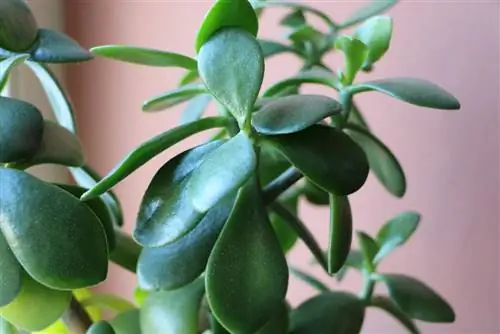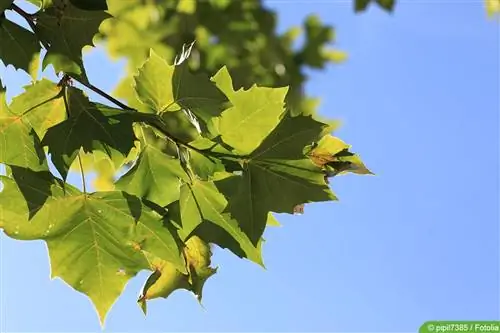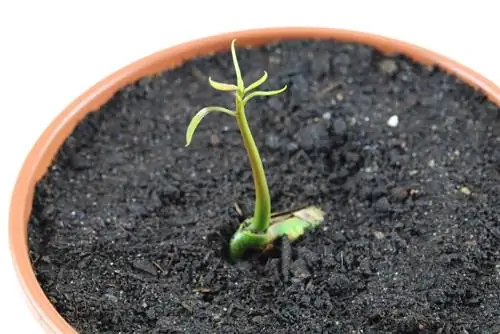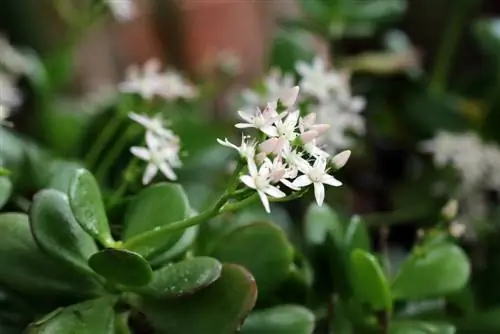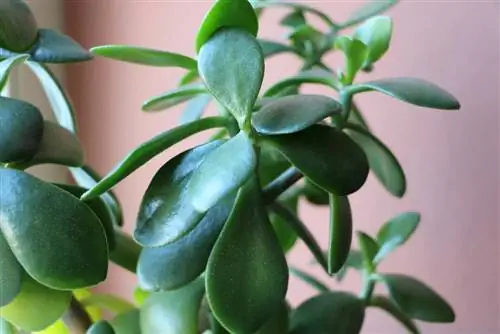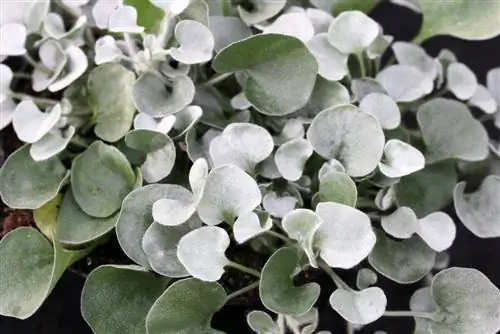- Author admin [email protected].
- Public 2023-12-17 03:39.
- Last modified 2025-01-24 12:45.
We know the pleasantly easy-care money tree well, so well that it is popularly given a variety of names such as penny tree, thickleaf, bacon oak, jade bush, elephant tree, Judas tree or German oak. It is less known that with the right stimulus to induce flowers it can become an attractive flowering plant. In addition to the instructions for care including flower induction, you will get to know interesting relatives of the best-known Crassula species, which are also cultivated as ornamental plants.
Profile
- The money tree belongs to the “Cacti & Succulents” category
- In terms of ornamental value, it is usually traded as an ornamental foliage plant
- Adult money trees can bloom beautifully and lushly
- What they rarely do here due to the lack of correct flower induction
- Flowering only works when the winter is cool and dry
- Otherwise, caring for the money tree is child's play
- Location: As sunny as possible, otherwise the “leaf decoration” is limited to “green on green”
- Watering: As carefully as possible (waterlogging!) and almost not at all in winter
- Plants: In loose (cactus) soil, fertilize with green plant or cactus fertilizer
- Apart from Crassula ovata, some members of the genus are cultivated as ornamental plants
Location, light
The succulent decorative leaf plant reaches a height of between 50 cm and 1.30 m. The penny tree grows like a normal shrub, but with its fleshy, oval-rounded leaves it appears significantly more massive than non-succulent houseplants. Crassula ovata branches abundantly and creatively in all directions - with its shiny, reddish-edged foliage on many shoots that seem to spiral up in a somewhat "uncoordinated" manner, it can certainly resemble a coral. The 1.30 m should indicate the maximum growth height that we can expect.
You probably won't grow a monster penny tree like this, but the picture of the giant is a good way to see the growth of a money tree: the trend is clearly towards width, at least to the same extent as height. Even for one of the more compact growing varieties, which do not grow taller than around 50 cm, you will need a fairly spacious parking space in the long run.
However, it will still take a few years until the newly acquired young plant or the cutting that came into the house as a gift (money trees are supposed to make their owners rich) is ready. The young plant can fit anywhere, which is why you should give it one of the brightest locations your living space has to offer. The reason: Crassula ovata belongs to the Cape Flora kingdom, and this South African Kapensis (the smallest of the six continental floral kingdoms) is “a little closer to the equator” than Germany, so the Pfennigbaum gets “a little more light” in its homeland than in Germany us.
This applies to spring, autumn and the location during wintering (more on this below). The plants in the “brightest locations” get their light through the window glass, resulting in a little less light intensity, actually for a South African plant this is more dark than bright. A sunny, warm location on the south window is therefore definitely appropriate.
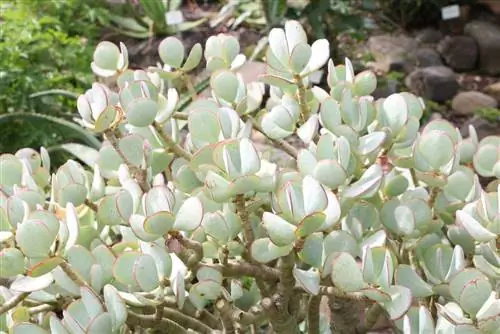
If you read (as you often do) that a penny tree can survive on a few hours of morning or evening sun, that may be true in terms of “pure survival”. However, such information could also be the reason why the majority of German money trees do not make it from the “uniform green” stage to the “variegated foliage plant” stage. There is even a source that gives the money tree a minimum lighting intensity of 1800 lux - bright room lighting has an average of around 500 lux, bright office lighting around 600.
A good compensation for low-light indoor culture is a summer location in the garden or on the balcony. But please carefully get used to the direct sun (plants also get sunburned) and protected from constant rain.
In contrast to many other tropical plants, money trees do not cause any problems when it comes to humidity; succulent plants can tolerate any degree of dryness in the air (as long as they have received enough water from below to fill their reservoirs).
The money tree tolerates everything in terms of temperatures that can occur on the edge of a South African Karoo or Namib desert with sometimes very hot days and quite cold nights; You will never exploit this range in a German home.
Money Tree Care
Caring for the money tree in our latitudes is not particularly complicated; the high temperature and drought tolerance in particular suit our culture well. In addition, succulents “Crassula ovata” (you will get to know a few more ornamental plants from the genus below) are robust contemporaries that will forgive the occasional (minor) care mistake. Of course, they thrive better without care mistakes, e.g. B. when caring for it according to the following instructions:
- Plant in finished cactus soil or 50% potting soil + 25% sand + 25% clay granules
- Water well in summer until water runs into the saucer
- Remove this water after a few minutes
- Only add water again when the substrate is almost dry
- Only water moderately during the rest period from October to February
- With just enough water so that the soil does not dry out completely and the ball does not become dry
- As always: Avoid waterlogging, succulents are particularly prone to root rot
- Rainwater is pleasant, but tap water that is not too hardy is also suitable
Tip:
After purchasing, pay attention to whether the succulent is “filled up”. If the plant is limp and the leaves appear thin and soft, you should water a little more. Only until each leaf shines bulgingly full. Water must never remain standing in the drain container for any longer, even during this “storage filling treatment”.
- There is no fertilization at all in the first year if potting is done in standard (pre-fertilized) potting soil
- Otherwise in the growth phase from April to September
- Amount depending on the nutritional content of the mixture used
- Overall, fertilize rather cautiously; in case of doubt, Crassula ovata gets along better with too few nutrients than too many
- Suitable is e.g. B. Liquid fertilizer for green plants and/or cacti
- For soil rich in humus with many organic components in half the recommended concentration
- Cactus soil or a loose mixture with lots of sand/mineral components tolerate a little more fertilizer
- Repotting if the roots are “scratching the pot wall” or looking out of the drainage hole
- In the first season after repotting in fresh potting soil from the store, the money tree does not need any fertilizer
Tip:
If we talked about “watering well until water runs into the saucer” above, this assumes that the plant is growing in a substrate that is suitable for plant growth: loose, i.e. permeable to water, but still put together in a kind of composite that water can be stored. Unfortunately, there are still too many commercial potting soil products that quickly turn into a substrate that is unsuitable for plant growth and is neither loose nor storable. If you pour in at the top, water runs out pretty quickly at the bottom (“water always finds its way,” as the old roofer preached), but unfortunately it just ran straight through without going through the roots. Diving for a longer period helps in such cases in the short term, repotting into fresh ones Soil is a better idea in the long term.
Flower induction
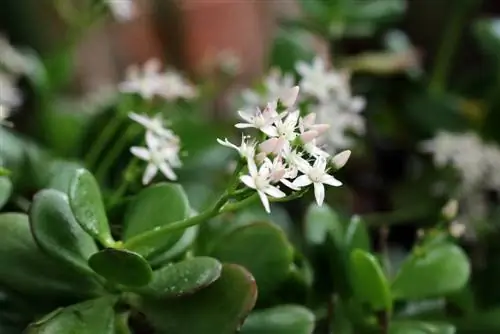
The money trees can bloom, extremely pretty, with small white to white-pink star flowers, which are decorated with small flower crowns on the inside and look very lively thanks to the fine, long stamens. These flowers only develop on the older specimens, but then one of the pretty inflorescences next to the other - provided that you overwinter the penny tree in a way that stimulates it to induce flowers.
Overwintering stimulates the money tree to induce flowers. If it takes place under conditions similar to those of overwintering in the money tree's homeland. The money tree blooms in South Africa in winter, from June to August. If the temperatures are roughly the same as in our summer, there is nothing stopping the money tree from blooming in this direction.
The flowering of the money tree takes place in the South African autumn/beginning of winter, i.e. in our spring. At temperatures that roughly correspond to our living room temperatures during the day and tend from just under 15 °C towards 10 °C at night. If the money tree is to produce flowers, it would have to be kept cold for a while. Since you certainly don't want to move the money tree every day, the best way to give it the cool it needs is to overwinter it in a cool, bright place. For example, together with other exotic animals in a cold house, at temperatures between 7 and 14 °C, or in a suitable side room.
Flower induction also requires keeping it a little drier than during flowering, so water the money tree very moderately (little sips) and only when the potting soil feels dry to the depths.
If the money tree has spent the summer in the garden (on the balcony), you can simply leave it there (and gradually water less) until the night temperatures settle around 7 °C. When there is frost, it is moved to winter quarters; this treatment is usually enough to induce flowers; in the garden variant, the money tree is exposed to cold temperatures as required.
If you have to overwinter the money tree at living room temperatures due to a lack of cool space, it should be kept as dry as possible during this time so that it slows down its growth. If you do not force the money tree to rest during the winter under such conditions by watering sparingly, it will try to grow in the warm, but in the dull winter light it will produce nothing but long, pale, thin horny shoots.
Cutting
You can prune a money tree whenever and however you want, it actually sprouts from every he althy part of the plant.
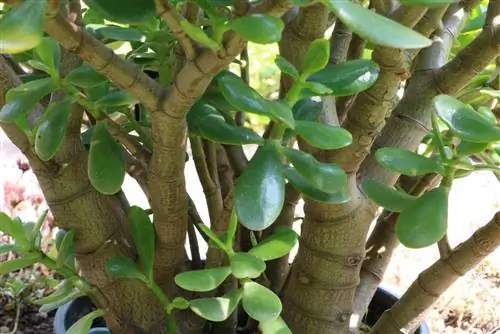
A cut is due e.g. B. to remove the long, thin horny shoots just described at the beginning of the growth phase or to remove damaged/soft/rotting plant parts.
You can also shorten shoots that are only visually disturbing, cut a penny tree that has grown too tall (after two or three decades) to chest height or grow the money tree as a bonsai with radical topiary.
Species and varieties
Crassula ovata, the best-known money tree, is offered (also under the synonyms C. argentea, C. obliqua, C. portulacea) in different varieties that differ in leaf shape and color:
- C. ovata 'Gollum' develops sausage fingers like its namesake
- C. ovata 'Hobbit', also tubular leaves + compact growth, hardly distinguishable from 'Gollum'
- C. ovata 'Hummel's Sunset', lots of red in the leaves, abundant flowers
- C. ovata 'Tricolor', decorative leaves in yellow, green and pink
- C. ovata 'undulata' really makes quite a wave
- C. ovata 'variegata', yellow striped leaves on a gray-green background
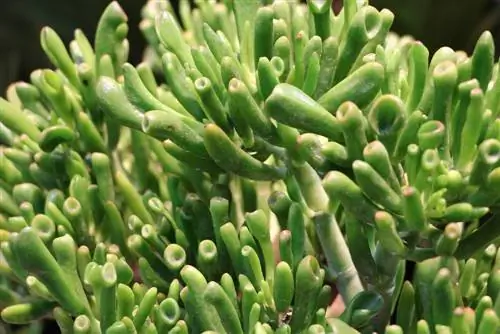
The Crassula are a species-rich genus of plants in the family Crassulaceae; currently almost 300 species are recognized. Some of these are cultivated as houseplants, in a wide variety of shapes and sizes, which are easily available from us except Crassula ovata:
- Crassula arborescens: Another excursion into literature, this time into the Discworld
- Crassula falcata, “disc leaves” under exciting red flowers
- Crassula muscosa, a many-leaved “green cone” on the other
- Crassula pellucida, triangular leaves in green, white, pink
- Crassula perforata grows in neatly geometric, red-edged squares
- Crassula rupestris, perforata in small
Since the Crassulae happily develop variants when breeding, the other money trees often come in various shapes, C. arborescens as a wavy 'undulata', C. muscosa as a colorful 'variegata', etc.
Propagation
Propagation is very easy using cuttings: cut the shoot, let it dry and plant it in cactus soil.
Leaf cuttings can also be planted, but often take weeks to months to root.
Problems cause the following typical care errors:
- Location too dark: sparse growth, long thin horny shoots, loss of color, in extreme cases leaf drop
- “Watering too well”, waterlogging: most common cause of leaf drop and “mushy shoots”
- Too much water during wintering at living room temperatures: horny shoots, root rot
- Pest infestation is rare, mealybugs etc. can also be showered on the smooth leaves if in doubt
Conclusion
If you have overwatered a money tree, repotting it and removing soft shoots and rotten roots may be able to save it. However, if all parts of the plant feel soft, it is better to cut cuttings from the he althy shoots straight away (and keep them at half the water level in hydroponics, excessive watering is excluded here).

